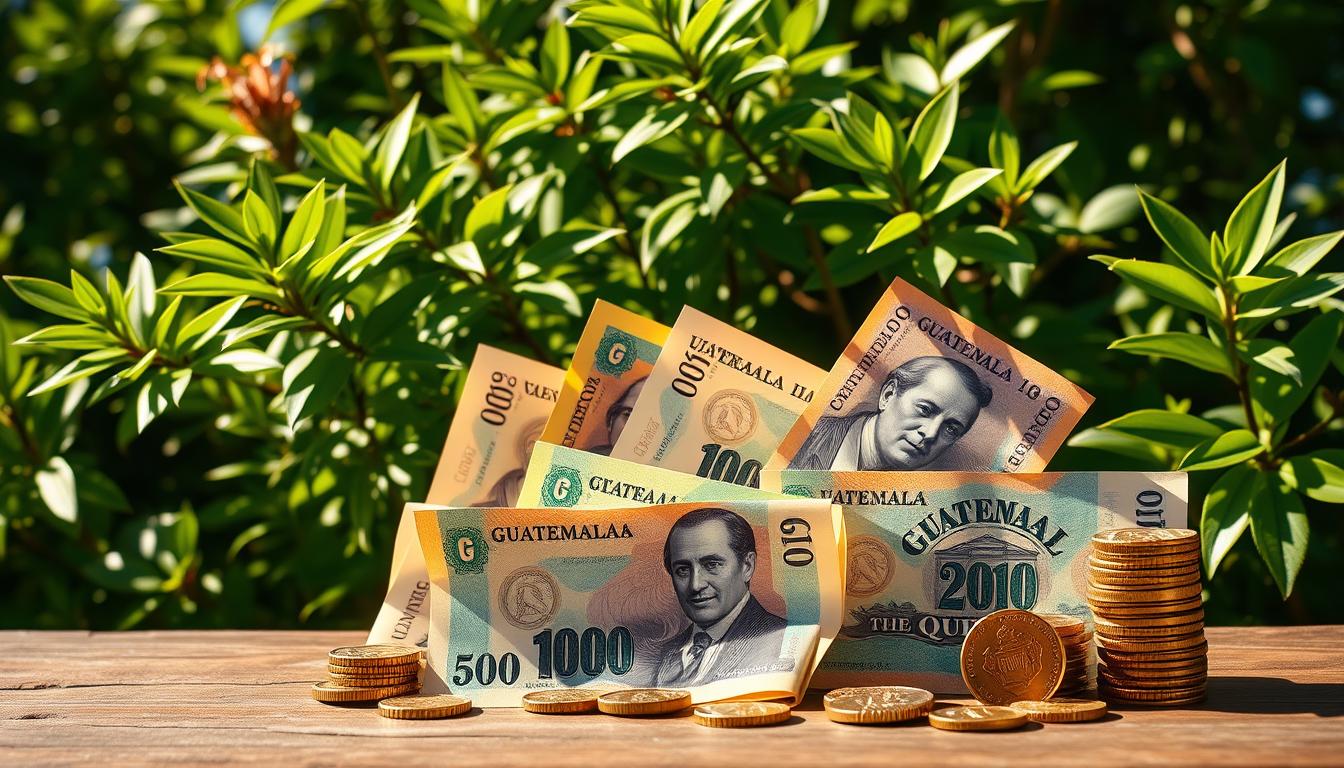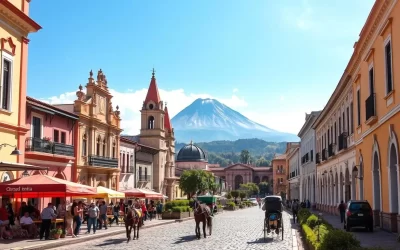✓ Accommodations ✓ Flights ✓ Rental Cars ✓ Tours & Activities
Did you know that over 50 businesses in Lago Bitcoin, Panajachel, accept Bitcoin as a form of payment? This is just one example of how diverse and unique the currency landscape can be in this vibrant country.
Understanding the exchange rate between the U.S. dollar (USD) and the Guatemalan Quetzal (GTQ) is crucial for any trip. The current rate is approximately 8 GTQ to 1 USD. Knowing this can help you plan your budget and avoid unnecessary fees.
Exchanging money before your departure is a smart move. Avoid airport exchanges where rates are often less favorable. Using a travel debit card can also save you money and provide convenience.
This guide will walk you through everything you need to know about managing your currency and payments while traveling. From practical tips to local insights, we’ve got you covered. Let’s make your trip smooth and stress-free!
Overview of Currency and Payment Options in Guatemala
Navigating money matters in a new country can be tricky, but understanding your options makes it easier. The official currency here is the Guatemalan Quetzal (GTQ). It’s widely accepted, and you’ll find it useful for most transactions.
Before you travel, check the live exchange rate between the U.S. dollar (USD) and GTQ. Online tools can help you track the mid-market rate, ensuring you get the best value for your money.
When exchanging currency, avoid airport kiosks and hotels. These often charge higher fees. Instead, visit local banks or trusted exchange offices for better rates.
Using a card can be convenient, but always carry some cash. Smaller shops and local markets may not accept cards. This dual approach gives you flexibility and peace of mind.
Keep an eye on costs in local shops. Prices can vary, so having a mix of payment options ensures you’re prepared for any situation. With these tips, you’ll handle your finances like a pro.
Guatemala: Ultimate Travelers Guide to Currencies & Payments
A little preparation goes a long way when it comes to managing your travel budget. This guide is here to help you navigate the essentials of currency and payment options, ensuring a smooth and stress-free trip.
First, it’s crucial to have the right currency on hand. The local GTQ is widely accepted, and carrying cash is essential for smaller shops and markets. However, don’t rely solely on cash—having a card as a backup is a smart move.
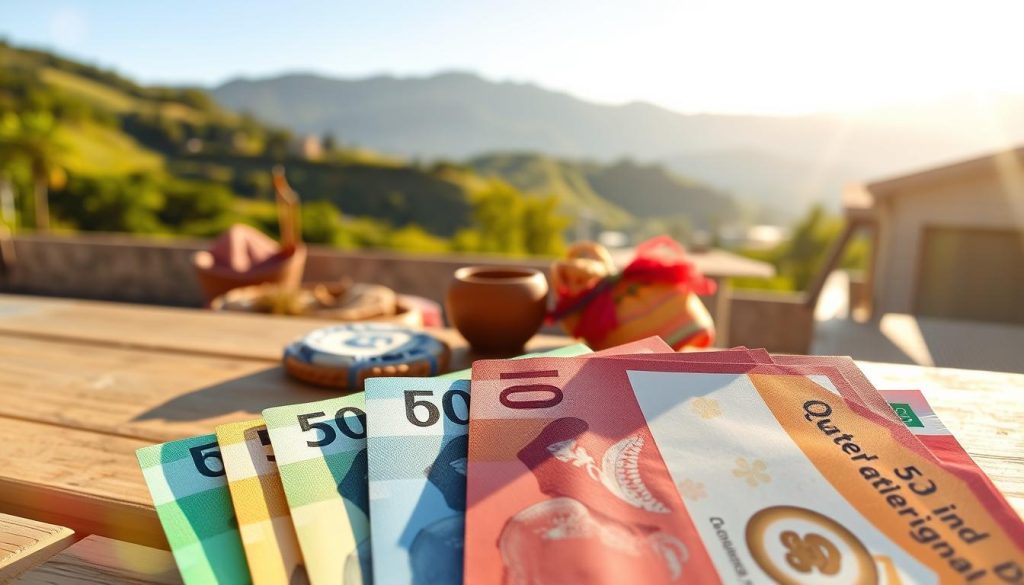
Before you leave, check the exchange rate between the USD and GTQ. Online tools and apps can help you track the mid-market rate, ensuring you get the best value for your money. Avoid exchanging currency at airports or hotels, as they often charge higher fees.
Here’s a tip: visit local banks or trusted exchange offices for better rates. Websites like XE or OANDA can also provide real-time updates on the exchange rate.
This guide covers everything from practical tips to local insights. By following these strategies, you’ll be well-prepared to handle your finances like a pro. Stay tuned for detailed advice in the upcoming sections!
Exchange Rate Essentials and Money Exchange Strategies
Exchange rates can make or break your travel budget if you’re not careful. Understanding the difference between the mid-market rate and the rate offered to customers is crucial. The mid-market rate is the rate banks use for buying and selling currencies. However, the rate you get often includes a markup.
To get the best deal, monitor live USD/GTQ rates using online tools like XE or OANDA. These platforms provide real-time updates, helping you compare rates effectively. Avoid exchanging money at airports or hotels, as they often charge higher fees. Instead, visit local banks or trusted exchange offices for better rates.
“Always check the mid-market rate before exchanging currency. It’s the benchmark for fair pricing.”
Here are some strategies to ensure you’re getting the best rate:
- Use online converters to track the mid-market rate.
- Compare rates at multiple locations before exchanging.
- Carry a mix of cash and a travel card for flexibility.
Knowing the right rate can save you money and make your trip smoother. By following these tips, you’ll avoid hidden fees and unfavorable rates, ensuring you get the most out of your travel budget.
Practical Tips for Exchanging Money in Guatemala
Exchanging money in a foreign country doesn’t have to be stressful if you know the right strategies. With a little preparation, you can avoid unnecessary fees and ensure you get the best rates. Here’s how to handle your currency exchange like a pro.
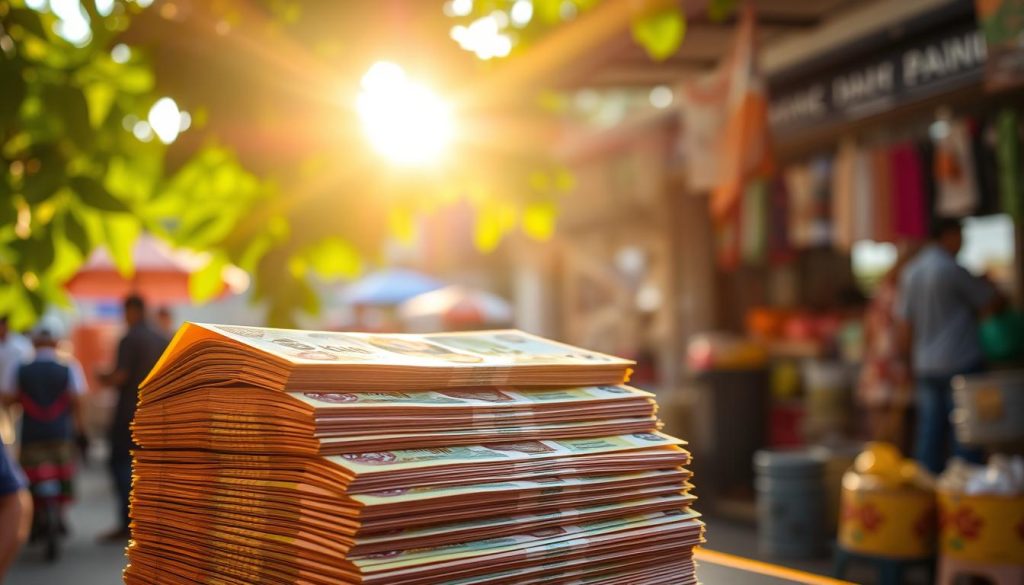
Where to Exchange Safely
First, avoid exchanging money at airports or hotels. These places often charge higher fees and offer less favorable rates. Instead, visit local banks or trusted exchange offices. They typically provide better rates and are more reliable.
Using local ATMs is another smart option. Always choose to withdraw in the local currency (GTQ) to avoid dynamic currency conversion fees. Be sure to check your bank’s international withdrawal fees beforehand to minimize costs.
“Local banks and ATMs are your best bet for fair exchange rates and secure transactions.”
Here are some additional tips to keep in mind:
- Carry a mix of cash and a travel card for flexibility.
- Compare rates at multiple locations before exchanging.
- Verify fees and read transaction details carefully to avoid hidden charges.
Pre-travel exchange can also save you money. Exchanging a small amount before you leave ensures you have local currency on hand for immediate needs. By following these tips, you’ll handle your payments confidently and avoid unnecessary expenses.
Using Debit and Credit Cards Abroad in Guatemala
Using cards abroad can simplify your travel experience if you know the right strategies. Debit and credit cards are widely accepted in larger establishments, but smaller shops and markets often prefer cash. Knowing how to use your card effectively can save you time and money.
When using ATMs, always choose to withdraw in the local currency (GTQ) to avoid dynamic currency conversion fees. Verify that the ATM displays the local currency option before completing the transaction. This simple step can save you from unnecessary costs.
Travel cards like the Wise Multi-Currency Card are excellent options. They often have lower foreign transaction fees compared to traditional bank cards. Compare fees and exchange rates before choosing the right card for your trip.
“Always notify your bank before traveling to avoid unexpected card rejections.”
Here’s a quick guide to using cards effectively:
- Carry a mix of cash and cards for flexibility.
- Choose cards with no or low foreign transaction fees.
- Notify your bank of your travel plans to prevent blocks.
If your card is lost or rejected, contact your bank immediately. Having a backup payment method ensures you’re never stranded. By following these tips, you’ll manage your finances confidently and avoid unnecessary headaches.
| Card Type | Pros | Cons |
|---|---|---|
| Debit Card | Direct access to funds, low fees | Limited fraud protection |
| Credit Card | Rewards, fraud protection | Higher foreign transaction fees |
| Travel Card | Low fees, multi-currency support | Limited acceptance in some areas |
Cash vs. Card: Navigating Guatemalan Transactions
Choosing between cash and card payments can make a big difference in how smoothly your trip goes. Both options have their advantages, and knowing when to use each can save you time and money.
Smaller shops, local markets, and taxis often prefer cash. These businesses may not accept cards, so carrying some local currency is essential. For larger purchases, like hotel stays or restaurant bills, using a card is usually more convenient and secure.
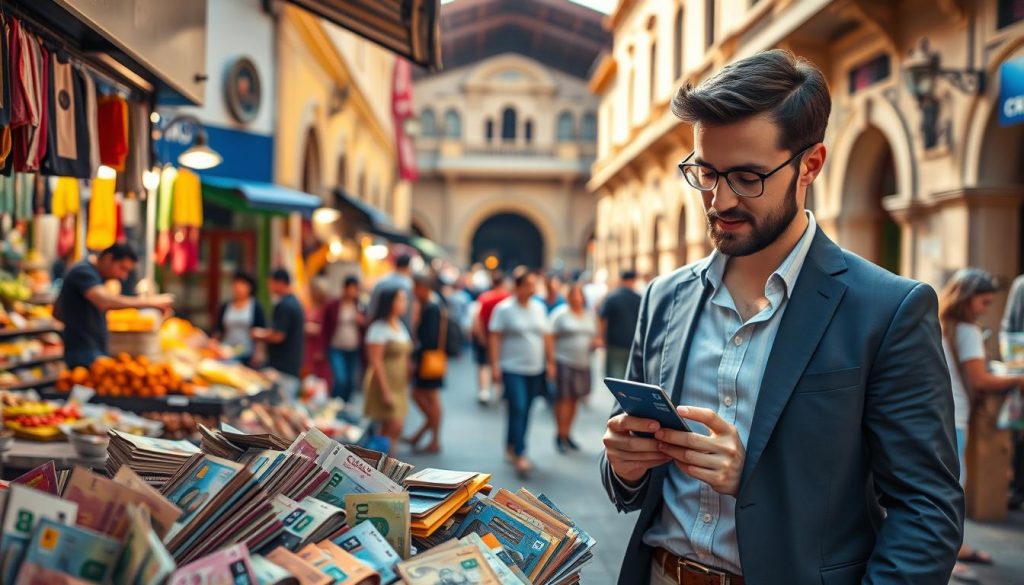
Optimal Use of Travel Cards
Travel cards, especially those with low foreign transaction fees, are a great way to manage your payments. They offer convenience and security, especially for larger expenses. However, always carry a small amount of cash for smaller transactions or tips.
“Balancing cash and card usage ensures you’re prepared for any situation, whether it’s a quick snack or a major purchase.”
Here are some strategies to help you decide:
- Use cards for larger purchases to avoid carrying too much cash.
- Keep cash on hand for small shops, markets, and transportation.
- Notify your bank before traveling to avoid unexpected card rejections.
By following these tips, you’ll handle your travel expenses confidently. Whether it’s a day at the market or a fancy dinner, the right payment method can make all the difference.
Understanding Costs: Daily Expenses and Budgeting
Planning your daily expenses can make or break your travel experience. Knowing what to expect helps you budget effectively and avoid surprises. From meals to transportation, here’s a breakdown of typical costs and tips to manage your money wisely.
Budgeting for Meals and Local Dining
Food is a big part of your daily spending. Street food is an affordable option, with items like tamalitos or pupusas costing around $1–$1.50. For a sit-down meal at a local restaurant, expect to pay between $4 and $6 per dish. High-end spots might charge up to $15, so choose wisely based on your budget.
Local markets are great for fresh produce and snacks at lower prices compared to supermarkets. If you’re staying in a hostel or guesthouse, cooking your meals can save you a couple of dollars each day. Balancing eating out and cooking ensures you enjoy local flavors without overspending.
“Street food is not only affordable but also a delicious way to experience local culture.”
Here are some tips to stretch your food budget:
- Opt for street food or local markets for affordable meals.
- Choose mid-range restaurants for a mix of quality and value.
- Cook simple meals if your accommodation has a kitchen.
Hidden Fees and Extra Charges
Be aware of hidden fees that can add up quickly. Some restaurants include a service charge, while others expect a tip. Always check the bill to avoid surprises. Transportation costs can also vary, so confirm prices before hopping on a bus or taxi.
Using credit cards is convenient, but some places may charge extra for card payments. Carrying cash for smaller transactions ensures you’re prepared for any situation. By planning ahead, you can enjoy your trip without worrying about unexpected expenses.
Whether you’re exploring local markets or dining out, managing your daily costs lets you focus on the adventure. With these tips, you’ll make the most of your time and money, ensuring a memorable and stress-free experience.
Planning for Acatenango and Other Adventures
Exploring the great outdoors here is a highlight for many, with the Acatenango hike being a top choice. This trek offers a mix of physical challenge and stunning scenery, making it a must-do for any adventure enthusiast. Proper planning ensures you get the most out of this unforgettable experience.
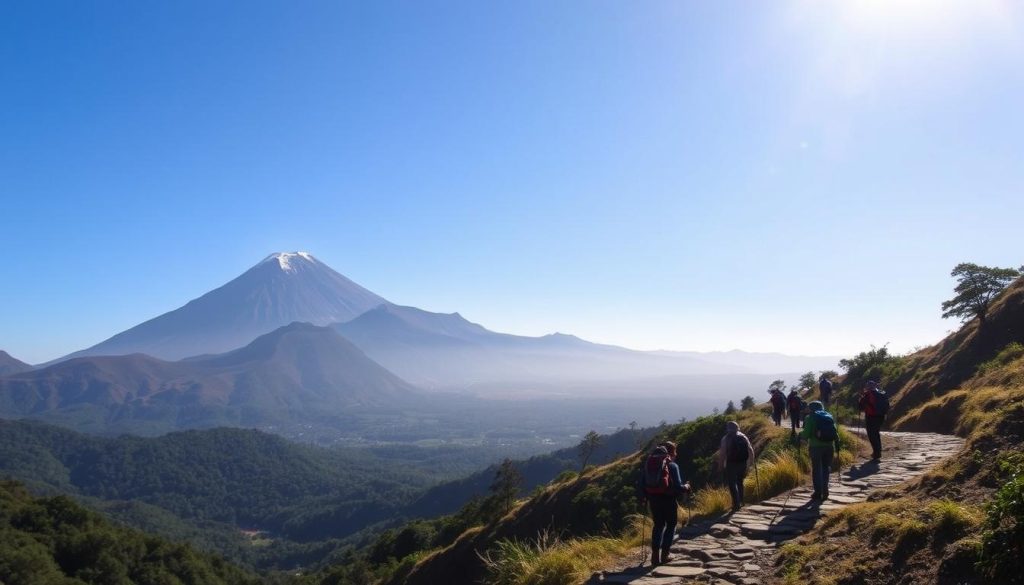
Acatenango Hike Overview
The Acatenango hike is a rewarding activity that takes you through diverse landscapes, from lush forests to volcanic terrain. The roundtrip distance is approximately 18 kilometers (11 miles), with an ascent time of 5 hours and a descent of 4 hours. The effort is well worth it for the breathtaking views at the summit.
Most tour groups charge between $50 and $80 USD, depending on the services included. This cost typically covers guides, meals, and equipment rentals. Some tours offer additional perks like porters or more substantial meals, so compare options to find the best value for your trip.
“The Acatenango hike is a once-in-a-lifetime experience that combines physical challenge with awe-inspiring views.”
Budgeting and Preparation Tips
When planning your hike, consider the following tips to ensure a smooth experience:
- Budget Wisely: Factor in additional expenses like snacks, water, and tips for guides. Carrying local currency is essential for small purchases along the way.
- Pack Smart: Bring layers for varying temperatures, sturdy hiking boots, and at least 2 liters of water. Don’t forget a headlamp for early morning starts.
- Choose the Right Time: The dry season (November to April) is ideal for hiking, with clearer skies and better trail conditions.
Comparing Costs with Other Activities
The Acatenango hike offers excellent value compared to other local activities. For example, a day trip to Lake Atitlán or a guided tour of Antigua might cost around $30-$50 USD. While these are enjoyable, the Acatenango trek provides a unique blend of adventure and natural beauty that’s hard to match.
| Activity | Cost (USD) | Duration |
|---|---|---|
| Acatenango Hike | $50-$80 | 1-2 days |
| Lake Atitlán Tour | $30-$50 | 1 day |
| Antigua Guided Tour | $25-$40 | Half-day |
By planning ahead and budgeting wisely, you can make the most of your travel experience. Whether it’s the Acatenango hike or other local adventures, these activities will leave you with lasting memories.
Traveling Beyond Currency: Time and Connectivity
Managing your time and staying connected are just as important as handling your finances when traveling. While currency and payments are crucial, understanding the local time zone and having reliable connectivity can make your trip smoother and more enjoyable.
Time Zone Considerations
This country operates on Central Standard Time (UTC−06:00) year-round. If you’re traveling from the U.S., this means there’s no daylight saving adjustment. For example, if it’s 12 PM in New York, it’s 10 AM here. Adjusting your schedule to local time helps you avoid confusion and stay in sync with activities and communication back home.
“Sync your devices to local time as soon as you arrive to avoid missed appointments or calls.”
Staying Connected
Modern service standards in cities here include high-quality internet and a 5G rollout. Many hotels offer free Wi-Fi, making it easy to stay connected. For longer stays, consider purchasing a local SIM card. They’re affordable and provide better rates for data and calls compared to international plans.
Here are some tips to stay connected:
- Choose accommodations with reliable Wi-Fi and good service.
- Use a local SIM card or an international plan for mobile data.
- Download offline maps and apps to navigate without internet.
Connectivity Options Comparison
| Option | Pros | Cons |
|---|---|---|
| Hotel Wi-Fi | Free, convenient | May have limited speed or coverage |
| Local SIM Card | Affordable, high-speed data | Requires unlocked phone |
| International Plan | No need to switch SIMs | Higher costs for data usage |
By planning for both time and connectivity, you’ll ensure a seamless travel experience. Whether it’s adjusting to the local time or staying connected with loved ones, these details matter just as much as managing your payments.
Local Insights: Culture, Food, and Market Experiences
Immersing yourself in local traditions and cuisine can transform your journey into an unforgettable experience. From vibrant markets to hidden eateries, every corner offers a chance to connect with the culture and flavors of the region.
Uncovering Authentic Local Flavors
Sampling regional dishes is a must for any visitor. Street food like tamalitos or pupusas is both affordable and delicious, often costing just $1–$1.50. For a sit-down meal, local restaurants serve hearty dishes for $4–$6. High-end spots might charge up to $15, but the experience is worth it.
Markets are a treasure trove of fresh produce and snacks. The Chichicastenango market, for example, is a bustling hub where you can find everything from spices to handmade crafts. It’s a great place to experience the local way of life.
Exploring Artisan Shops
Artisan shops are another highlight. These small stores offer unique souvenirs like handwoven textiles, pottery, and jewelry. Supporting local artisans not only gives you a one-of-a-kind keepsake but also helps sustain traditional crafts.
Payment Tips for a Smooth Experience
While many places accept credit cards, smaller shops and markets often prefer cash. Always carry some local currency for these transactions. Using a card is convenient for larger purchases, but notify your bank before traveling to avoid unexpected rejections.
“Exploring local markets and eateries is the best way to experience the heart of a destination.”
Why These Experiences Matter
These cultural encounters are a vital part of any trip guatemala. They offer a deeper understanding of the region’s traditions and people. Whether it’s savoring street food or bargaining at a market, these moments create lasting memories.
| Experience | Cost (USD) | Tips |
|---|---|---|
| Street Food | $1–$1.50 | Try tamalitos or pupusas |
| Local Restaurant | $4–$6 | Opt for mid-range spots |
| Artisan Shop | Varies | Look for handmade textiles |
| Market Visit | Free | Bargain for the best deals |
By diving into these local experiences, you’ll gain a richer perspective on your destination. From food to markets, every moment is an opportunity to connect with the culture and make your trip truly special.
Conclusion
Exploring a new destination becomes seamless when you’re well-prepared with the right financial strategies. This guide has covered essential tips, from understanding the exchange rate between USD and GTQ to blending modern payment methods with traditional cash options. Always check the mid-market rate and notify your bank before your trip to avoid unexpected issues.
Carry a mix of cash and a card for flexibility. Smaller shops and markets often prefer cash, while larger establishments accept cards. This dual approach ensures you’re ready for any situation. Planning ahead helps you stay low cost while enjoying quality adventures.
By following these strategies, you’ll navigate your journey with confidence. Whether you’re exploring vibrant markets or hiking scenic trails, smart financial planning makes all the difference. Embrace the experience and enjoy every moment of your adventure!
The above is subject to change.
Check back often to TRAVEL.COM for the latest travel tips and deals.
